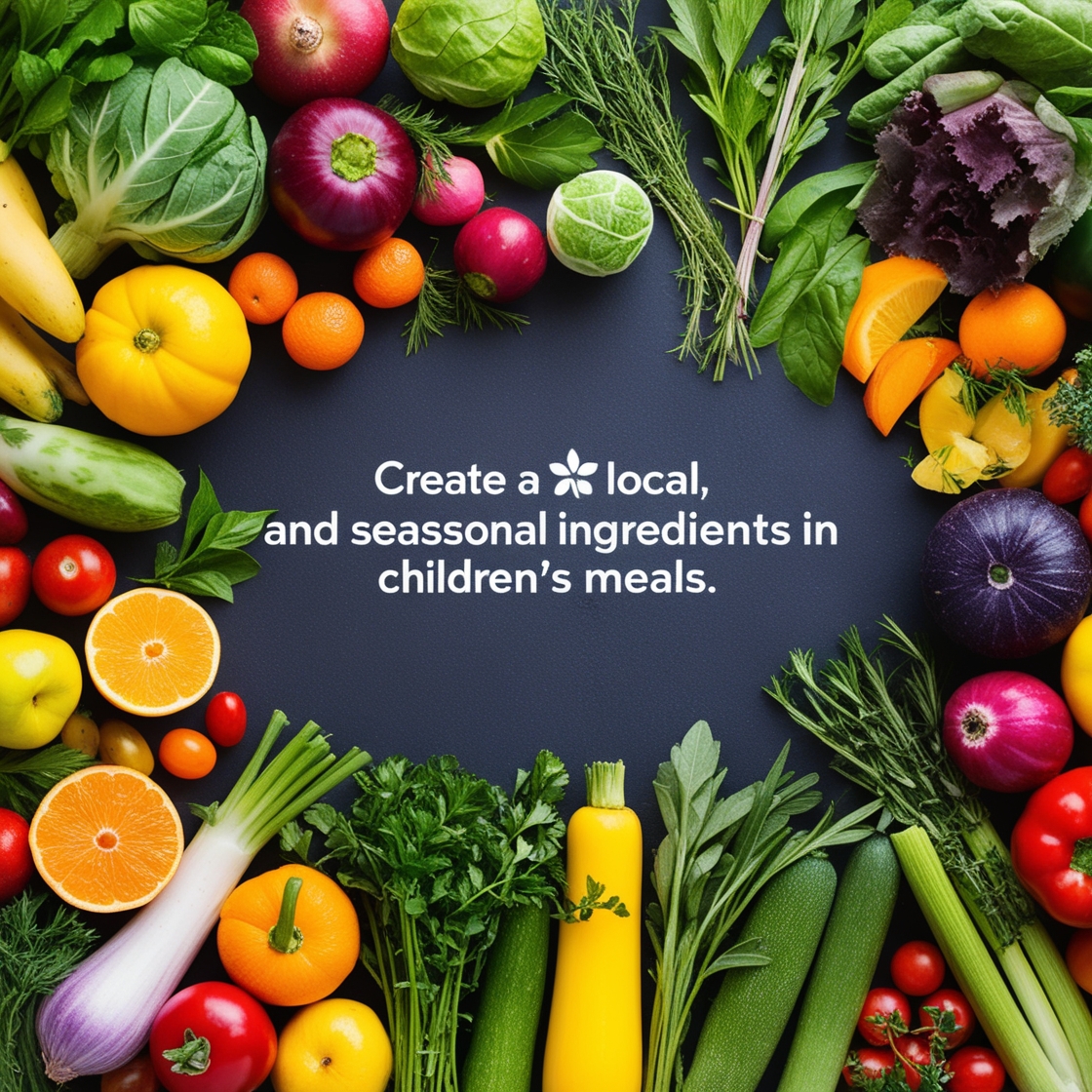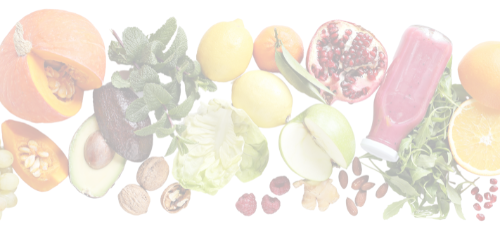
Local and seasonal food plays a critical role in creating healthy and nutritious meals for children. By incorporating fresh, seasonal produce, parents can offer meals that are more flavorful and packed with nutrients. Using local and seasonal ingredients has long-term health benefits for kids, improves the quality of meals, and supports local communities. In this article, we will explore the importance of local and seasonal ingredients in children’s diets, the benefits of eating with the seasons, and how to make the most of these foods.
What Is Local and Seasonal Food?
Local and seasonal food refers to produce that is grown and harvested within a specific region and consumed when it is naturally available during its growing season. Seasonal food changes throughout the year, allowing families to enjoy different fruits, vegetables, and herbs at their peak freshness. When parents choose local and seasonal food for their children’s meals, they not only offer better-tasting meals but also reduce the environmental impact associated with long-distance transportation.
Why Should You Eat Local and Seasonal Food?
Local and seasonal food is often more nutritious and fresher compared to produce that is shipped from far-away places. Vegetables and fruits grown in their natural season tend to develop more fully, which boosts their flavor and nutritional content. For kids, eating local and seasonal food ensures that they receive meals filled with vitamins, minerals, and antioxidants that contribute to healthy growth. Moreover, local farmers often use fewer preservatives, ensuring that the food kids consume is as natural as possible.
The Benefits of Eating Local and Seasonal Food for Kids
The benefits of eating local and seasonal food for children go beyond just better taste. Seasonal ingredients are typically more flavorful and nutritious because they are harvested at the peak of ripeness. This freshness enhances the overall meal experience for children and encourages them to enjoy a wider variety of fruits and vegetables. Moreover, local and seasonal ingredients are often more affordable, as they are in abundance during their growing season. Consequently, parents can provide nutritious meals for their kids without overspending on grocery bills.
Seasonal Ingredient Highlights
- Spring: Asparagus, peas, spinach, and strawberries. Recipes can include asparagus frittatas or pea and spinach purees.
- Summer: Tomatoes, corn, zucchini, and berries. Think of summer salads or berry smoothies.
- Fall: Pumpkins, apples, sweet potatoes, and carrots. Pumpkin soups or apple cinnamon oatmeal are great options.
- Winter: Brussels sprouts, kale, citrus fruits, and root vegetables. Recipes could feature kale chips or citrus-glazed carrots.
Fun Ways to Introduce Seasonal Produce
- Host simple cooking classes that focus on using seasonal ingredients.
- Organize trips to local farms to teach kids about where their food comes from.
- Encourage kids to grow their own herbs or vegetables at home.
By emphasizing the benefits of seasonal and local ingredients, you can help children develop a taste for fresh, wholesome foods while also supporting sustainable practices.
Why Seasonal Ingredients Matter in Kids’ Meals
Seasonal ingredients matter because they offer the freshest, most nutrient-dense produce available. Foods that are grown out of season are often picked before they are fully ripe and may lose some of their nutritional value during transport. By offering local and seasonal food, parents ensure that children enjoy the full health benefits of their meals. Additionally, eating seasonal produce introduces kids to a wide variety of flavors throughout the year, encouraging them to try new foods and broaden their palate.
Read Also:
– 10 Key Answers About Vegetables for Picky Eaters
Understanding the Importance of Local and Seasonal Ingredients
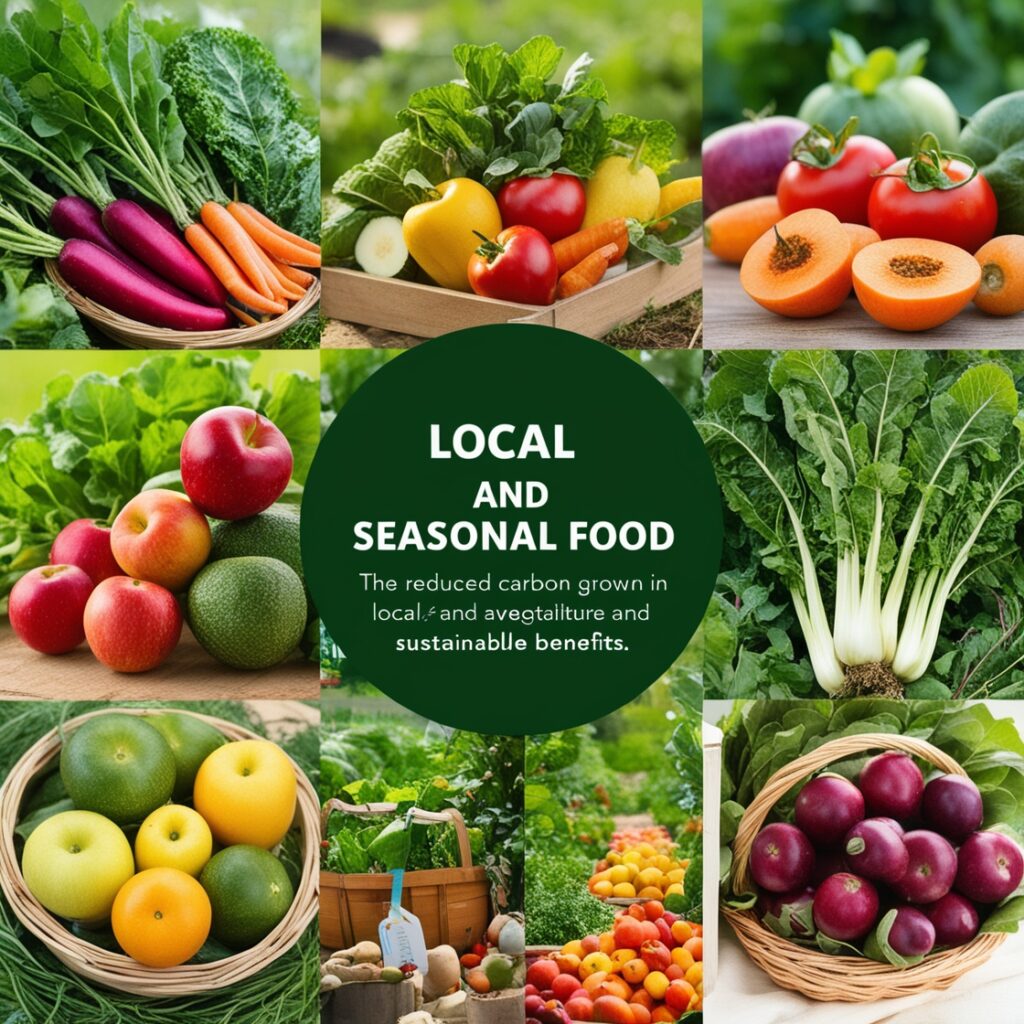
Local and seasonal food also has a significant environmental impact. By choosing food that is grown locally and in season, families reduce the carbon footprint associated with food transportation. This sustainable approach to eating helps reduce energy consumption and supports local agriculture. Moreover, when kids are introduced to local and seasonal food, they learn the importance of sustainability and develop healthy, eco-friendly habits that can last a lifetime.
The Role of Local and Seasonal Foods in Enhancing Sustainable Food Consumption
Incorporating local and seasonal food into children’s meals is a key part of sustainable food consumption. Supporting local farmers and reducing the environmental strain caused by shipping produce from other regions helps create a more sustainable food system. Moreover, local farmers often use environmentally friendly practices, such as minimal pesticide use, which leads to healthier food options for kids. Consequently, teaching children the value of eating seasonal and locally sourced ingredients fosters a sense of responsibility toward the planet.
Making the Most of Seasonal Ingredients in Kids’ Meals
Parents can make the most of local and seasonal food by planning meals around the fruits and vegetables available during each season. For example, spring brings an abundance of leafy greens and strawberries, while fall is known for root vegetables like carrots and pumpkins. By following a seasonal food guide, parents can ensure that their children enjoy a wide variety of fresh, healthy foods throughout the year. Moreover, incorporating seasonal foods into children’s diets can make meal planning more exciting and engaging for both kids and parents.
Reasons to Eat Local, Seasonal Food for Children’s Health

Local and seasonal food offers numerous benefits for children’s health. By incorporating these fresh ingredients into meals, children gain access to higher levels of essential nutrients, develop stronger immune systems, and foster a lifelong love for wholesome foods. Below is a deeper exploration of why local and seasonal ingredients matter, focusing on nutritional value, flavor, and variety.
1. Nutritional Value of Local and Seasonal Food
- Seasonal produce is often harvested at its peak ripeness, providing the highest levels of essential vitamins, minerals, and antioxidants. For instance, tomatoes picked in summer contain more lycopene than those grown out of season and transported long distances.
- Produce that travels long distances loses nutrients during transit. In contrast, local and seasonal food maintains higher nutrient levels because it reaches the consumer more quickly after harvest.
- Seasonal foods require less processing and preservation, which helps retain their natural nutritional benefits. Fresh spring asparagus, for example, is more nutritious than canned or frozen alternatives.
2. Local and seasonal food enhances the flavor of your dishes
- Fruits and vegetables grown in their natural season have had optimal time to develop their full flavor. Summer peaches and strawberries, for instance, are sweeter and juicier than out-of-season or greenhouse-grown counterparts.
- Many seasonal foods develop natural sugars when they’re in season, making them taste better and more appealing to children. For example, summer corn and winter squash are particularly flavorful.
- Seasonal produce often has better texture. Fresh, in-season apples, for example, are crisper and more enjoyable than those stored for months.
3. Variety of Local and Seasonal Food
- Eating seasonally introduces children to a wider variety of fruits and vegetables, encouraging them to expand their palates and try new foods. They might enjoy pumpkin dishes in the fall and watermelon in the summer.
- A diverse diet is key to balanced nutrition. Seasonal eating ensures children receive a variety of nutrients throughout the year, as each season offers different fruits and vegetables.
- Seasonal eating also provides educational opportunities, teaching children about food sources and helping them appreciate the natural food cycles.
As a consequence, incorporating local and seasonal food into children’s diets is an excellent way to boost their nutrition, enhance flavor, and diversify their meals. Seasonal ingredients not only provide essential nutrients but also foster a love for fresh, natural foods that can last a lifetime.
The Benefits of Incorporating Seasonal Produce Into Kids’ Daily Nutrition
Incorporating local and seasonal food into children’s meals offers numerous benefits for their overall health. Seasonal produce contains essential nutrients that support healthy development, including vitamins, fiber, and antioxidants. Additionally, eating with the seasons ensures that kids are exposed to a wide variety of flavors, textures, and colors, which can help reduce picky eating habits. Consequently, parents who prioritize seasonal ingredients in their kids’ diets contribute to their long-term health and well-being.
Tips for Emphasizing Seasonal Ingredients
- Create charts or posters showing which fruits and vegetables are in season throughout the year. This visual aid can help families plan their meals and understand what to look for at the market.
- Offer cooking demonstrations or workshops focused on preparing meals with seasonal ingredients. This hands-on approach can help kids and parents learn how to cook with fresh, in-season produce.
- Share recipes that highlight seasonal ingredients and provide tips on how to select and prepare them. For example, a summer fruit salad or a winter root vegetable roast can showcase the best of what each season has to offer.
By focusing on the benefits of seasonal ingredients, you can help promote healthier eating habits, make meals more enjoyable, and support local agriculture.

Seasonal Recipes
Spring
1. Spring Veggie Stir-Fry
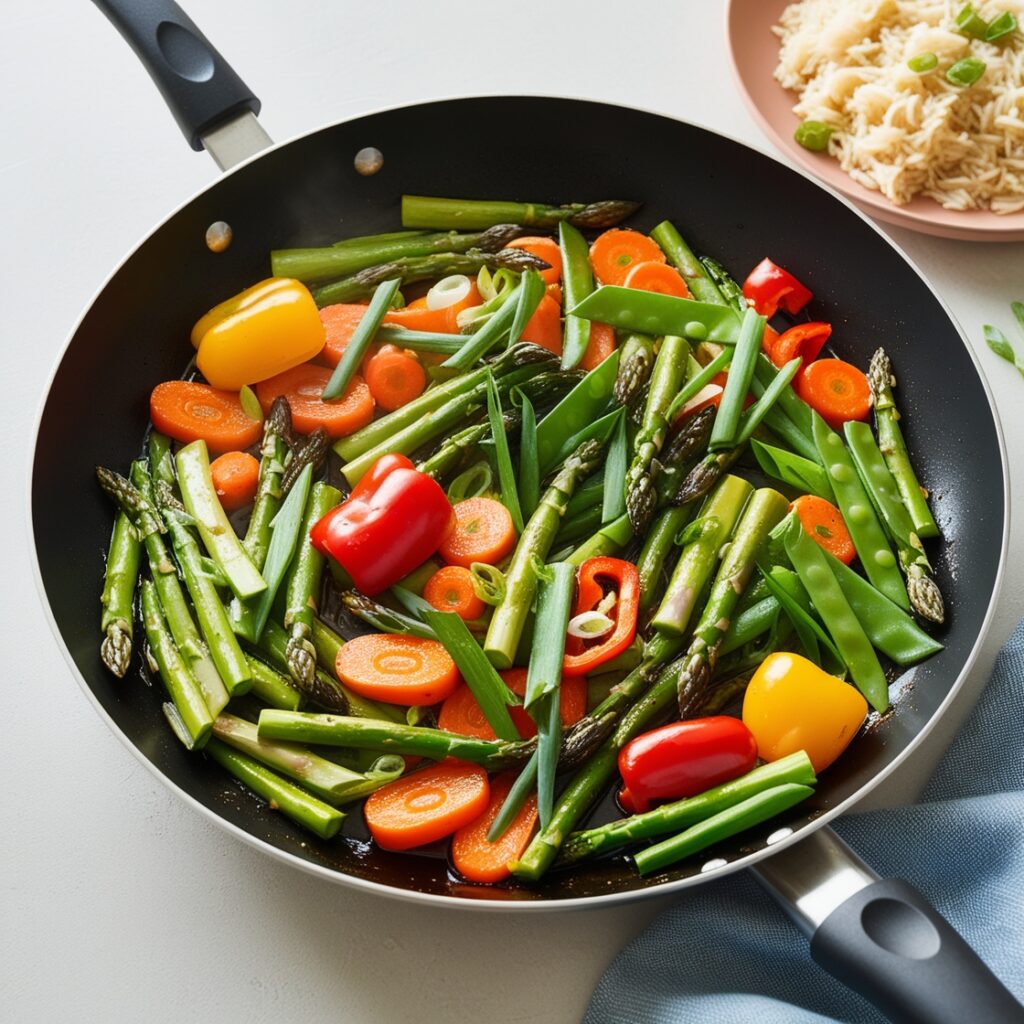
– Asparagus
– Snap peas
– Baby carrots
– Green onions
– Bell peppers (red or yellow)
– Garlic
– Soy sauce
– Olive oil
Instructions:
1. Preparation: Wash and cut asparagus into bite-sized pieces. Trim the snap peas and slice the carrots thinly. Chop bell peppers and green onions.
2. Cooking: Heat olive oil in a pan over medium-high heat. Add minced garlic and cook until fragrant. Add asparagus, snap peas, and carrots. Stir-fry for 3-4 minutes until vegetables are tender-crisp. Add bell peppers and cook for another 2 minutes.
3. Finishing: Stir in soy sauce to taste and cook for an additional minute. Serve with rice or noodles.
Tips:
– Choose bright green asparagus and vibrant snap peas with a crisp texture.
– For a crunchy texture, avoid overcooking vegetables.
2. Strawberry Spinach Salad

– Fresh spinach
– Strawberries
– Feta cheese
– Almonds (sliced)
– Balsamic vinaigrette
Instructions:
1. Preparation: Wash and slice strawberries. Tear spinach leaves into bite-sized pieces.
2. Assembly: In a large bowl, combine spinach, strawberries, and feta cheese. Top with sliced almonds.
3. Dressing: Drizzle with balsamic vinaigrette before serving.
Tips:
– Look for firm, brightly colored strawberries and fresh, tender spinach.
– Toss the salad gently to avoid wilting the spinach.
3.Lemon Herb Roasted Asparagus
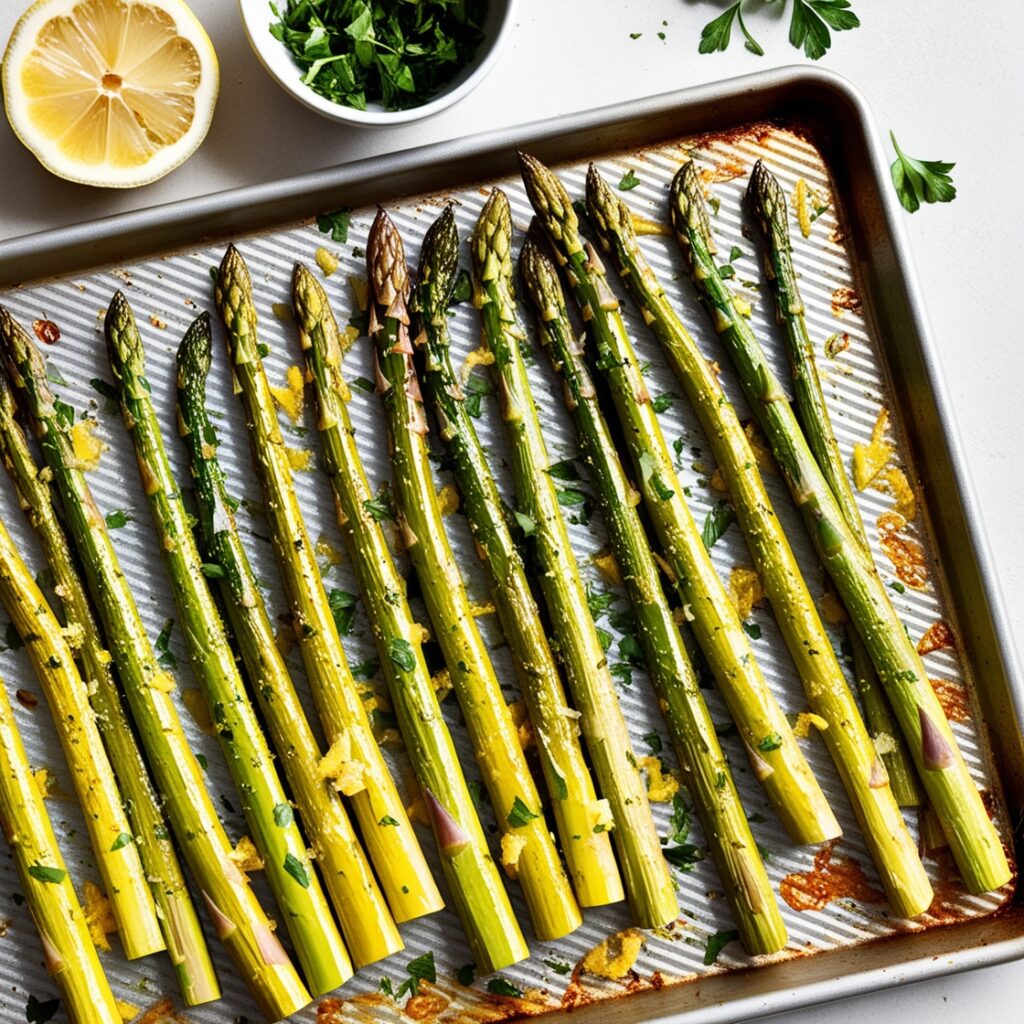
1 bunch of fresh asparagus (about 1 pound)
2 tablespoons olive oil
2 cloves garlic, minced
Zest and juice of 1 lemon
2 tablespoons fresh parsley, chopped
Salt and black pepper, to taste
Instructions:
Preparation:
Select the Asparagus: Choose bright green asparagus with firm stalks and closed tips. Avoid any that are limp or have woody ends.
Prepping: Rinse the asparagus under cold water and pat dry. Trim the woody ends by bending each stalk until it naturally snaps or cutting off the bottom 1-2 inches.
Cooking:
Preheat Oven: Set your oven to 400°F (200°C).
Seasoning: In a large bowl, toss the asparagus with olive oil, minced garlic, lemon zest, and lemon juice. Season with salt and black pepper.
Roasting: Spread the seasoned asparagus in a single layer on a baking sheet. Roast for 15-20 minutes, or until tender and slightly crispy on the edges.
Garnishing: After roasting, sprinkle with fresh chopped parsley for a burst of color and added freshness.
Tips :
Look for asparagus that is firm and has vibrant color. Thicker stalks are often more tender and flavorful, but any size can be delicious if cooked properly.
To avoid overcooking, monitor closely during roasting. Asparagus should be crisp-tender; overcooked asparagus can become mushy.
Experiment with additional herbs like thyme or basil if desired. A sprinkle of grated Parmesan cheese just before serving can add a savory depth.
This dish pairs beautifully with spring proteins like grilled chicken or fish and makes a delightful addition to a brunch spread.
Summer
1. Corn and Tomato Salad
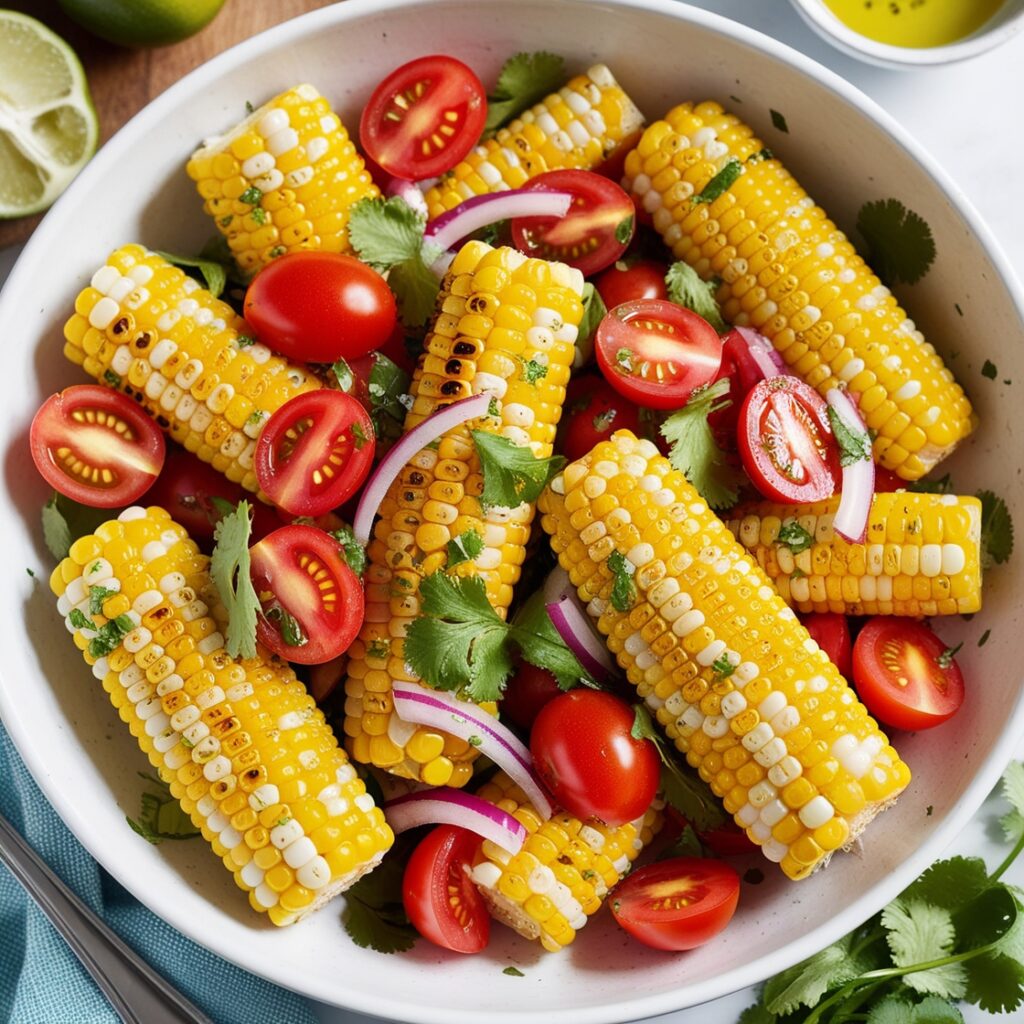
– Fresh corn on the cob
– Cherry tomatoes
– Red onion
– Cilantro
– Lime juice
– Olive oil
Instructions:
1. Preparation: Grill or boil corn until tender. Let it cool, then cut kernels off the cob. Halve cherry tomatoes and thinly slice red onion.
2. Mixing: In a bowl, combine corn, tomatoes, and onion. Add chopped cilantro and dress with lime juice and olive oil.
Tips:
– Choose corn with bright yellow kernels and firm tomatoes.
– Grill corn for extra flavor, or boil it for a quicker option.
2. Watermelon Feta Salad
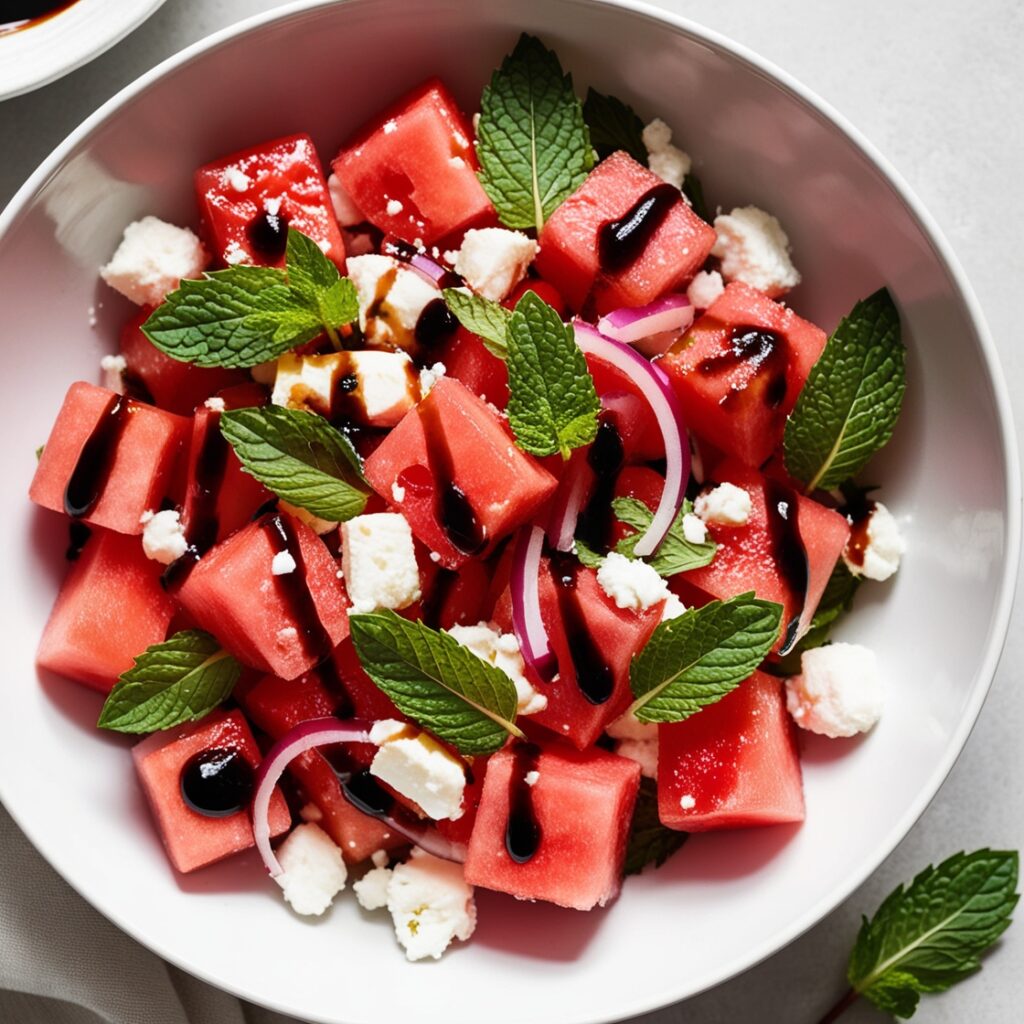
– Watermelon
– Feta cheese
– Mint leaves
– Red onion (optional)
– Balsamic glaze
Instructions:
1. Preparation: Cut watermelon into cubes. Crumble feta cheese.
2. Assembly: In a bowl, combine watermelon, feta cheese, and chopped mint leaves. Optionally, add thinly sliced red onion.
3. Finishing: Drizzle with balsamic glaze before serving.
Tips:
– Choose a ripe, sweet watermelon with a firm texture.
– Chill the salad before serving for a refreshing treat.
3.Peach and Tomato Salad with Fresh Basil

4 ripe peaches, sliced
2 cups cherry tomatoes, halved
1/2 red onion, thinly sliced
1/4 cup fresh basil leaves
1/4 cup crumbled feta cheese
2 tbsp extra-virgin olive oil
1 tbsp balsamic vinegar
Salt and freshly ground black pepper, to taste
Instructions:
Prepare the Ingredients:
-Wash and slice the peaches, halve the cherry tomatoes, and thinly slice the red onion.
-Gently tear the basil leaves into smaller pieces.
-Make the Dressing:
-In a small bowl, whisk together the olive oil, balsamic vinegar, salt, and pepper.
-Assemble the Salad:
-In a large bowl, combine the peaches, cherry tomatoes, and red onion.
-Drizzle with the dressing and toss gently to coat.
-Sprinkle the crumbled feta cheese and fresh basil leaves on top.
Serve:
-Serve immediately, or chill in the refrigerator for 30 minutes for flavors to meld.
-Tips for Selecting and Preparing Ingredients:
-Choose peaches that are firm yet slightly soft to the touch. They should have a fragrant aroma. Avoid peaches with blemishes or overly soft spots.
-Look for cherry tomatoes that are vibrant in color and firm. They should have a sweet, slightly tangy smell.
-Select basil leaves that are bright green and free from brown spots. Fresh basil adds a burst of flavor, so avoid dried basil for this recipe.
-Opt for high-quality feta cheese that’s creamy and tangy. It should crumble easily and add a delightful texture to the salad.
Preparation Tips:
-Slice peaches just before serving to prevent them from becoming mushy.
-Toss the salad gently to avoid bruising the fruit and vegetables.
-For extra flavor, consider adding a handful of toasted nuts or seeds.
Fall
1. Pumpkin Soup

– Fresh pumpkin (or canned pumpkin puree)
– Onion
– Garlic
– Vegetable broth
– Cinnamon
– Nutmeg
– Olive oil
Instructions:
1. Preparation: Peel, seed, and chop pumpkin. Sauté onion and garlic in olive oil until translucent. Add chopped pumpkin and cook for a few minutes.
2. Cooking: Add vegetable broth and spices. Simmer until pumpkin is tender. Blend until smooth.
3. Finishing: Serve hot with a swirl of cream if desired.
Tips:
– Choose a pumpkin with a hard, unblemished skin. If using canned puree, opt for 100% pumpkin with no added sugar.
– Use an immersion blender for easy blending, or transfer to a blender in batches.
2. Apple and Sweet Potato Mash

– Sweet potatoes
– Apples (such as Granny Smith or Honeycrisp)
– Butter
– Cinnamon
– Brown sugar (optional)
Instructions:
1. Preparation: Peel and chop sweet potatoes and apples. Boil until tender.
2. Mashing: Drain and mash sweet potatoes and apples together. Stir in butter, cinnamon, and a bit of brown sugar if desired.
Tips:
– Choose firm, unblemished sweet potatoes and apples.
– For a smoother mash, use a potato masher or food processor
3.Roasted Butternut Squash and Apple Soup

1 large butternut squash, peeled and cubed
2 large apples, peeled, cored, and chopped
1 large onion, chopped
3 cloves garlic, minced
4 cups vegetable broth
2 tablespoons olive oil
1 teaspoon ground cinnamon
1/2 teaspoon ground nutmeg
Salt and pepper to taste
Fresh thyme or parsley for garnish
Instructions:
Preparation: Preheat your oven to 400°F (200°C). Toss the butternut squash cubes and apple chunks with olive oil, cinnamon, nutmeg, salt, and pepper. Spread them evenly on a baking sheet.
Roasting: Roast in the preheated oven for about 25-30 minutes, or until the squash is tender and caramelized.
Sautéing: While the vegetables are roasting, heat a little olive oil in a large pot over medium heat. Sauté the onion and garlic until softened and translucent.
Blending: Once the squash and apples are roasted, add them to the pot with the sautéed onions and garlic. Pour in the vegetable broth. Bring to a simmer for about 10 minutes.
Pureeing: Use an immersion blender to blend the soup until smooth. Alternatively, carefully transfer the soup in batches to a blender.
Finishing Touches: Adjust seasoning with more salt, pepper, or spices if needed. Garnish with fresh thyme or parsley.
Tips :
-Look for a squash that is firm, heavy for its size, and has a smooth, matte skin. Avoid any with soft spots or blemishes. The skin should be a deep orange color.
-Choose firm apples with a vibrant color and a pleasant aroma. Varieties like Honeycrisp or Gala work well for their natural sweetness and crispness.
Select onions that are firm with dry, papery skins. Garlic should be plump and free from sprouting.
-Ensure vegetables are spread out in a single layer on the baking sheet to allow for even roasting. Stir halfway through to achieve a uniform caramelization.
-If using a regular blender, let the soup cool slightly before blending to prevent splattering. If using an immersion blender, make sure the soup is at a simmer.
Winter
1.Roasted Winter Vegetable Soup with Garlic and Herbs
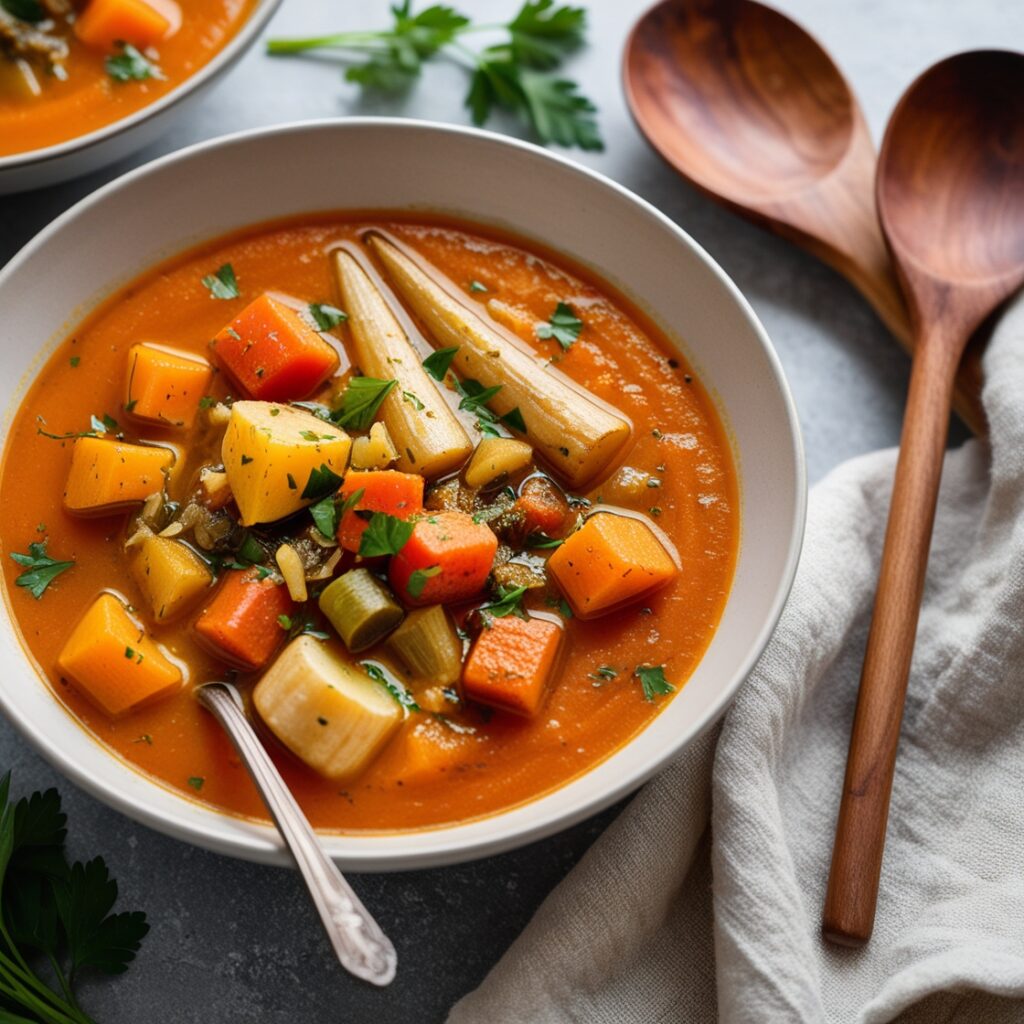
1 medium butternut squash, peeled and cubed
3 large carrots, peeled and chopped
2 parsnips, peeled and chopped
1 onion, quartered
4 cloves of garlic, unpeeled
2 tbsp olive oil
1 tsp dried thyme
1 tsp dried rosemary
4 cups vegetable broth
Salt and pepper to taste
Fresh parsley for garnish
Instructions:
Preparation: Preheat the oven to 400°F (200°C). On a baking sheet, toss the squash, carrots, parsnips, and onion with olive oil, thyme, rosemary, salt, and pepper. Add garlic cloves to the tray.
Roasting: Roast vegetables for 25-30 minutes or until tender and caramelized, flipping halfway through.
Blend: Once roasted, peel the garlic, and blend all the vegetables with the vegetable broth until smooth.
Heat and Serve: Transfer the soup to a pot and simmer for 10 minutes. Adjust seasoning and garnish with fresh parsley.
Tips :
Look for squash that feels heavy for its size with a firm, smooth skin. Avoid ones with soft spots.
Choose firm, brightly colored roots. These vegetables are sweeter in winter due to the cold temperatures converting starch to sugar.
Pick firm bulbs with tight skins for the best flavor.
2. Citrus Glazed Carrots

– Carrots
– Orange juice
– Honey
– Butter
– Orange zest
Instructions:
1. Preparation: Peel and slice carrots. Cook in boiling water until tender.
2. Glazing: In a pan, melt butter, then add orange juice and honey. Cook until slightly thickened. Toss carrots in the glaze and sprinkle with orange zest.
Tips:
– Choose carrots that are firm and have a vibrant color.
– For a more intense flavor, reduce the glaze slightly before adding the carrots.
3.Hearty Winter Squash and Kale Soup

Winter Squash (butternut or acorn): 1 large, peeled and cubed
Kale: 2 cups, washed and chopped
Carrots: 2, diced
Onion: 1 large, chopped
Garlic: 3 cloves, minced
Vegetable Broth: 4 cups
Olive Oil: 2 tablespoons
Salt and Pepper: to taste
Thyme: 1 teaspoon dried or a few sprigs fresh
Nutmeg: a pinch
Parmesan Cheese (optional): for garnish
Instructions:
Preparation: Peel and cube the winter squash. Wash and chop the kale. Dice the carrots and chop the onion. Mince the garlic.
Cooking:Heat olive oil in a large pot over medium heat. Add onions and carrots, cooking until softened, about 5 minutes.
Add garlic and cook for an additional minute.
Stir in the cubed squash and thyme, cooking for another 5 minutes.
Pour in the vegetable broth and bring to a boil. Reduce heat and simmer until the squash is tender, about 20 minutes.
Add the chopped kale and cook for an additional 5 minutes until the kale is tender.
Use an immersion blender to puree the soup until smooth (or carefully transfer to a blender in batches). Season with salt, pepper, and a pinch of nutmeg.
Garnish with grated Parmesan cheese if desired.
Tips :
-Choose a squash that feels heavy for its size and has a hard, blemish-free skin. The color should be vibrant and the skin should be firm. Avoid any with soft spots or visible cracks.
-Use a sharp knife to cut through the tough skin. It’s helpful to microwave the squash for a few minutes to make peeling easier. Alternatively, you can roast the squash to enhance its flavor before adding it to the soup.
-Look for kale with deep green, crisp leaves and sturdy stems. Avoid any that are wilted, yellowed, or have brown spots.
-Wash kale thoroughly to remove any grit. Remove the tough stems and tear or chop the leaves into bite-sized pieces. Kale can be massaged with a bit of olive oil and salt to soften its texture if preferred.
Conclusion: Why Eat Local and Seasonal Food?
In conclusion, incorporating local and seasonal food into kids’ meals is essential for promoting healthy eating habits, supporting sustainability, and offering nutrient-rich meals. Seasonal ingredients are typically more flavorful, affordable, and environmentally friendly, making them an excellent choice for families. Parents who prioritize seasonal and local produce will not only improve their children’s health but also teach them the value of eating with the seasons and supporting local communities.
Read Also:

